Setting the Wireless LAN to Use from Other Computers (Windows) (MF4570dw)
| Article ID: ART111671 | | | Date published: 05/11/2015 | | | Date last updated: 08/17/2015 |
Description
Solution
Setting the Wireless LAN to Use from Other Computers (Windows)
important:
Check the following before installing the MF drivers.
- The computer and machine are connected over the network.
- The machine is powered ON.
- The IP addresses are properly set up.
- Turn on the computer, and then log on as a user with administrative privileges.
- If you have already logged on, exit all applications which are running.
Installing using [Easy Installation]
* When you are in an IPv6 environment, you may not be able to use the installation procedure below to install the MF drivers.
See "Installing the MF Drivers on the WSD Network" to install the MF Drivers.
* Note that you cannot use the scan functions in an IPv6 environment.
1. Insert the User Software CD-ROM into the slot on your computer.

2. Click [Easy Installation].

When the language selection screen is displayed before the CD-ROM setup screen appears.
- Select the language and click [Next].
[Easy Installation] performs the installation of the following software.
- Printer driver
- Fax driver
- Scanner driver
- MF Toolbox
To add the following software and manual to the installation, select [Custom Installation].
- Presto! PageManager
- e-Manual
If the top screen does not appear.
- Windows 2000, XP, and Server 2003:
1. From the [Start] menu, select [Run].
2. Enter "D:\Minst.exe", and then click [OK].
- Windows Vista, 7, and Server 2008:
1. Enter "D:\Minst.exe" in [Start Search] or [Search programs and files] under the [Start] menu.
2. Press the [ENTER] key on the keyboard.
* The CD-ROM drive name is indicated as "D:" in this manual. The CD-ROM drive name may differ depending on the computer you are using.
3. When the following screen appears, select the connection type.
Click [Next] for [Connect Printer Directly to Computer].
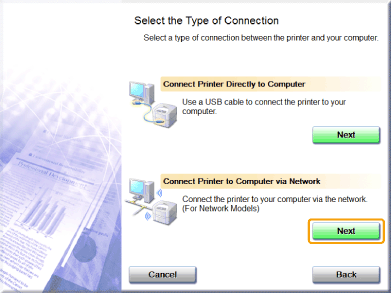
Windows Server 2003/Server 2008
- This screen is not displayed. Proceed to the following procedure.
4. Click [Install].
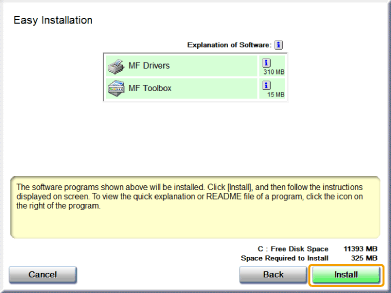
5. Read the License Agreement and click [Yes].

6. Click [Next].
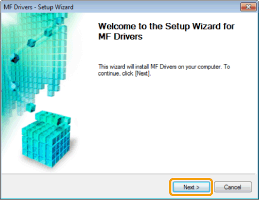
The following screen appears. Click [Yes].
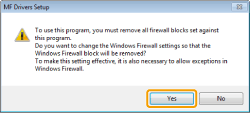
7. Select the device to be installed.
(1) Select the device.
(2) Click [Next].
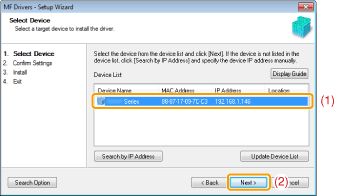
When no devices are displayed in [Device List]
- Try the following procedure.
1. Check the following.
- The computer and machine are connected over the network.
- The device for wireless LAN connection and the access point are connected.
- The machine is turned ON.
- The IP address is set correctly.
- The computer and machine are on the same subnet.
- Security software is disabled.
2. Click [Update Device List].
- If the problem persists, try the following procedure.
1. Click [Search by IP Address].
2. Enter the IP address of the machine.
* If the IP address of the machine is set between "169.254.1.0 and 169.254.254.255", it means that the IP address is automatically assigned to the machine in the auto configuration procedure.
When the IP address is not a link-local address, set up your computer and the machine to be on the same subnet.
This allows the installer to search the machine.
(See "Setting IPv4 Address" in the )

3. Click [OK].
- If any devices are not displayed by performing the above procedure, click [Display Guide] to solve the problem.
8. Click [Start] to begin installation.
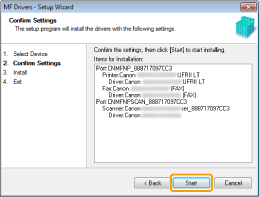

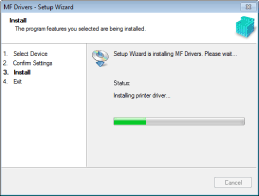
9. Click [Exit].

Continue with the steps in the procedure below to start installation of the MF Toolbox.
* The MF Toolbox cannot be installed on Windows 2000 Server/Server 2003/Server 2008 computers. Installation is skipped and proceed to Step 10.
10. Click [Next].
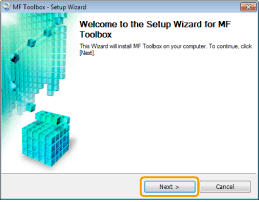
11. Click [Start].

12. Confirm that the applications are selected [  ] under [Install] and click [Next].
] under [Install] and click [Next].
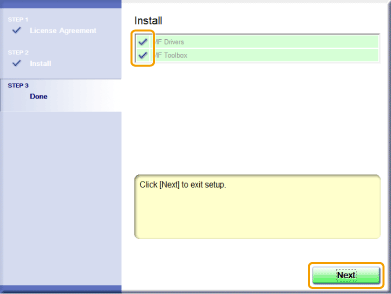
13. Restart your computer.
(1) Select the [Restart Computer Now (Recommended)] check box.
(2) Click [Restart].
* The CD-ROM can be ejected once this screen appears.

To connect the machine to the network, check the installation results.
"Checking the installation results"
Installing using [Custom Installation]
* When you are in an IPv6 environment, you may not be able to use the installation procedure below to install the MF drivers.
See "Installing the MF Drivers on the WSD Network" to install the MF Drivers.
* Note that you cannot use the scan functions in an IPv6 environment.
1. Insert the User Software CD-ROM into the slot on your computer.

2. Click [Custom Installation].

When the language selection screen is displayed before the CD-ROM setup screen appears.
- Select the language and click [Next].
[Easy Installation] performs the installation of the following software.
- Printer driver
- Fax driver
- Scanner driver
- MF Toolbox
To add the following software and manual to the installation, select [Custom Installation].
- Presto! PageManager
- e-Manual
If the top screen does not appear.
- Windows 2000, XP, and Server 2003:
1. From the [Start] menu, select [Run].
2. Enter "D:\Minst.exe", and then click [OK].
- Windows Vista, 7, and Server 2008:
1. Enter "D:\Minst.exe" in [Start Search] or [Search programs and files] under the [Start] menu.
2. Press the [ENTER] key on the keyboard.
* The CD-ROM drive name is indicated as "D:" in this manual. The CD-ROM drive name may differ depending on the computer you are using.
3. When the following screen appears, select the connection type.
Click [Next] for [Connect Printer to Computer via Network].

Windows Server 2003/Server 2008
- This screen is not displayed. Proceed to the following procedure.
4. Select the check box next to the application you want to install and click [Install].
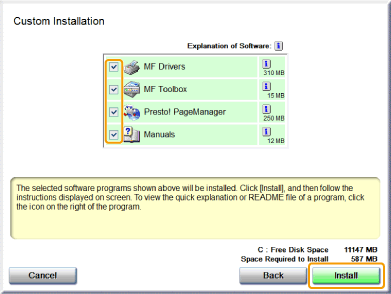
5. Read the License Agreement and click [Yes].

6. Click [Next].

The following screen appears. Click [Yes].

7. Select the machine you want to install.
(1) Select the machine.
(2) Click [Next].

When no devices are displayed in [Device List].
- Try the following procedure.
1. Check the following.
- The computer and machine are connected over the network.
- The device for wireless LAN connection and the access point are connected.
- The machine is turned ON.
- The IP address is set correctly.
- The computer and machine are on the same subnet.
- Security software is disabled.
2. Click [Update Device List].
- If the problem persists, try the following procedure.
1. Click [Search by IP Address].
2. Enter the IP address of the machine.
(See "Checking IP Address Settings" in the )
* If the IP address of the machine is set between "169.254.1.0 and 169.254.254.255", it means that the IP address is automatically assigned to the machine in the auto configuration procedure.
When the IP address is not a link-local address, set up your computer and the machine to be on the same subnet.
This allows the installer to search the machine.
(See "Setting IPv4 Address" in the )

3. Click [OK].
- If any devices are not displayed by performing the above procedure, click [Display Guide] to solve the problem.
8. Select the driver to install.
(1) Select the driver that you want to install.
(2) Click [Next].

| [Printer] | Install to use the print functions. |
| [Fax (for Supported Models)] | Install to use the fax functions on your computer. (Once you have the driver installed on your computer, you can send your document or image files to a fax-enabled device directly from your computer.) |
| [Scanner] | Install to use the scan functions. |
9. Set the printer or fax information.
(1) Enter the correct information.
(2) Click [Next].
 Printer information*1
Printer information*1

 Fax information*2
Fax information*2

*1 Appears when [Printer] is selected in Step 8.
*2 Appears when [Fax (for Supported Models)] is selected in Step 8.
| [Printer Name] | Enter a different name to change the default name. |
| [Fax Name] | |
| [Use as Shared Printer] | Select the check box to set the printer or fax as a shared printer or fax. |
| [Use as Shared Fax] | |
| [Shared Name] | Specify the shared name. |
When the [Use as Shared Printer] or [Use as Shared Fax] check box is selected.
- Follow the steps in the procedure below to install the additionally required driver.
1. Click [Drivers to Add].
2. Select the operating system displayed for [Drivers to Add].

3. Click [OK].
* When you are using a 64-bit operating system on your computer, the driver cannot be downloaded from the network onto computers using the following 32-bit operating systems.
- Windows 2000
- Windows XP (without service packs or SP1 installed)
- Windows Server 2003 (without service packs installed)
If you download and install the software on any of the above 32-bit operating systems, you may fail to install the software and may not be able to open the printing preferences dialog box.
* When you are using one of the following 32-bit operating systems on your computer, the driver cannot be downloaded from the network onto computers using 64-bit operating systems.
- Windows 2000
- Windows XP (without service packs or SP1 installed)
- Windows Server 2003 (without service packs installed)
10. Click [Start] to begin installation.



11. Select the printer that you use most often.
(1) Select the printer that you use most often.
(2) Click [Next].
* This screen appears only when installing the printer driver and fax driver.
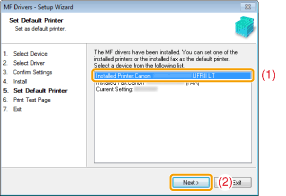
12. Select to print a test page.
(1) Select the check box to print a test page.
(2) Click [Next].
* This screen appears only when installing the printer driver.
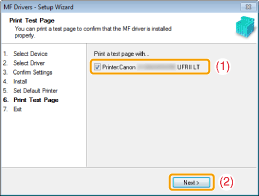
13. Click [Exit].

Continue with the steps in the procedure below to start installation of the MF Toolbox.
The MF Toolbox cannot be installed on Windows 2000 Server/Server 2003/Server 2008 computers, or if the [MF Toolbox] check box is cleared in Step 4. Installation is skipped and proceed to Step 16.
14. Click [Next].
The screens appear successively to specify where to install the MF Toolbox and add it to the start menu. Click [Next] after you have made your selections.
Then, click [Start] in the displayed screen.

15. Click [Exit].

The applications of which check boxes were selected in Step 4 will be installed.
Follow the onscreen instructions.
16. Confirm that the applications are selected [  ] under [Install] and click [Next].
] under [Install] and click [Next].
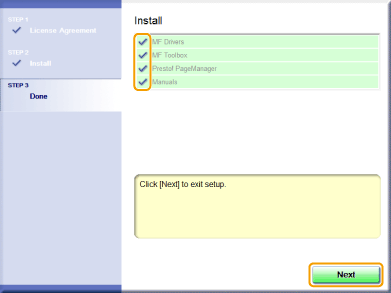
17. Restart your computer.
(1) Select the [Restart Computer Now (Recommended)] check box.
(2) Click [Restart].
The CD-ROM can be ejected once this screen appears.

To connect the machine to the network, check the installation results.
"Checking the installation results"
Installing the MF Drivers on the WSD Network
You can print from a Windows Vista/7/Server 2008 computer using the WSD (Web Services on Devices) protocol.
To use WSD, follow the procedures provided in "Installing the MF Drivers" and "Setting WSD."
When you are in an IPv6 environment.
You cannot install the MF Drivers from the CD-ROM setup screen.
Follow the steps in the procedure below.
To enable or disable WSD.
Enable or disable WSD from the machine's operation panel. For more information, see "Selecting the Connection Method (LPD/RAW/WSD)." in the e-Manual.
1. Open the printer folder.
- Windows 2000:
From the [Start] menu, select [Settings] and [Printers].
- Windows XP Professional, and Server 2003:
From the [Start] menu, select [Printers and Faxes].
- Windows XP Home Edition:
From the [Start] menu, select [Control Panel], click [Printers and Other Hardware] and [Printers and Faxes].
- Windows Vista:
From the [Start] menu, select [Control Panel] and click [Printer].
- Windows 7, and Server 2008 R2:
From the [Start] menu, select [Devices and Printers].
- Windows Server 2008:
From the [Start] menu, select [Control Panel], and then double-click [Printers].
2. Click [Add a printer].
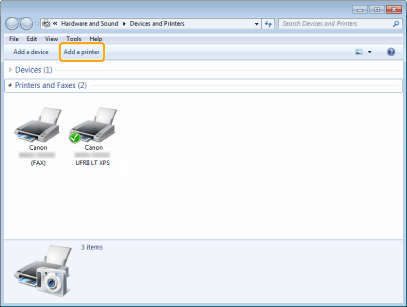
3. Click [Add a local printer].
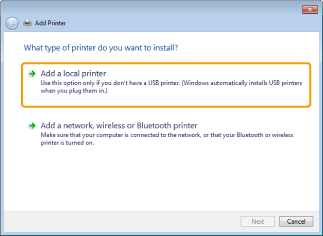
4. Confirm that [LPT1: (Printer Port)] is displayed for [Use an existing port] and click [Next].
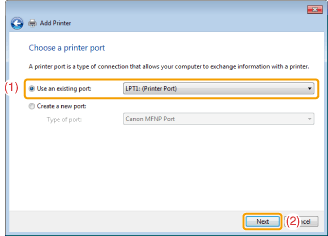
5. Click [Have Disk].
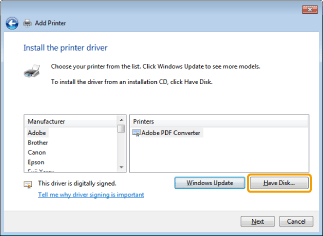
6. Insert the User Software CD-ROM into the slot on your computer.
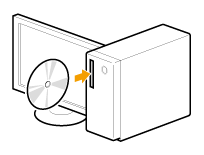
When the following screen appears, click [Exit].
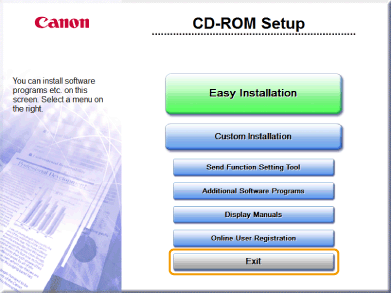
When [AutoPlay] is displayed.
Click [  ] to close the dialog box.
] to close the dialog box.
7. Click [Browse].
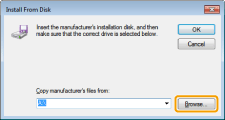
8. Open the folder where the printer driver files are stored.
- For 32-bit versions:
Open [DRIVERS] -> [us_eng] -> [32bit] -> [win2k_vista] on the CD-ROM and click [Open].
- For 64-bit versions:
Open [DRIVERS] -> [us_eng] -> [x64] -> [Driver] on the CD-ROM and click [Open].
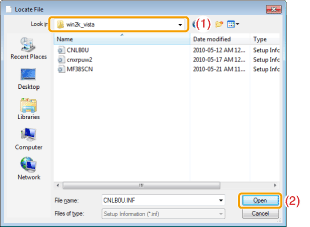
When you are not sure which operating system that you are using on your computer.
1. Select [Control Panel] from the [Start] menu.
2. Display [System].
- Windows Vista/Windows 7/Windows Server 2008 R2:
Click [System and Maintenance] or [System and Security] -> [System].
- Windows Server 2008:
Click [System].
3. Check the process version.
- For 32-bit versions:
[32-bit Operating System] is displayed.
- For 64-bit versions:
[64-bit Operating System] is displayed.
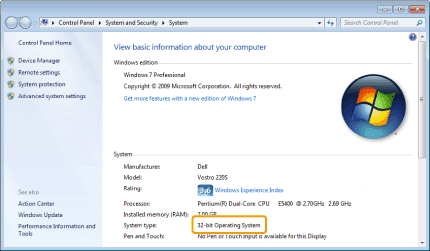
9. Click [OK].
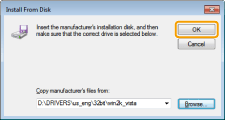
10. Select the printer driver you are using, and then click [Next].
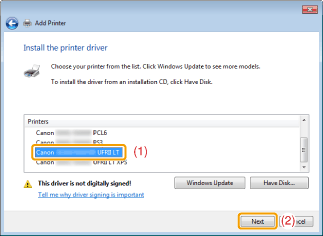
11. Specify the printer name.
(1) Enter a different name to change the default printer name.
When [Set as default printer] is displayed, specify whether to choose the machine as the default printer (Windows Vista/Server 2008).
(2) Click [Next].
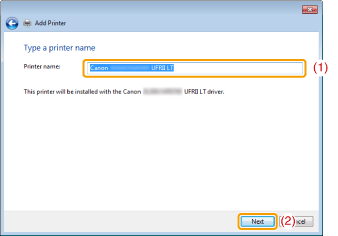
-> Installation begins. Wait until the following screen closes.
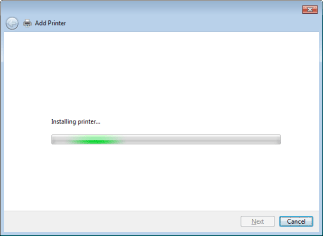
When [User Account Control] appears.
Click [Yes] or [Continue].
12. Select [Do not share this printer] and click [Next].
*To set the machine as a shared printer, configure the related settings after you have performed the procedure provided in "Setting WSD."
 Setting WSD
Setting WSD
1. Open the network folder.
- For Windows Vista/Server 2008:
Select [Network] from the [Start] menu.
- For Windows 7/Server 2008 R2:
Select [Computer] from the [Start] menu and click [Network].
2. Right-click the machine icon and select [Install] from the pop-up menu.
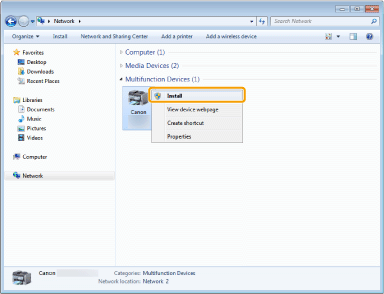
-> The icon is add to the printer folder. Installation is complete.
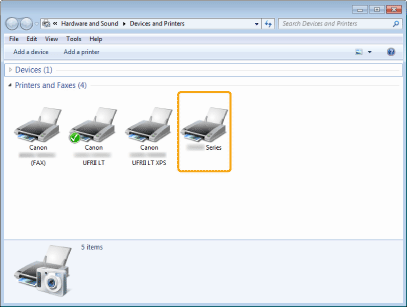
When [User Account Control] appears.
Click [Yes] or [Continue].
Follow the steps in the procedure below to delete the icon added in Step 13, if you do not need it.
(1) Right-click the icon and select [Remove device] or [Delete] from the pop-up menu.
(2) Click [Yes].
(3) When [User Account Control] appears, click [Yes] or [Continue].
13. Click [Finish].
*When [Set as the default printer] is displayed, specify whether to choose the machine as the default printer (Windows 7/Server 2008 R2).
*Eject the CD-ROM when the following screen appears.
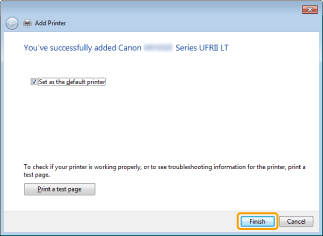
-> The icon is added to the printer folder.
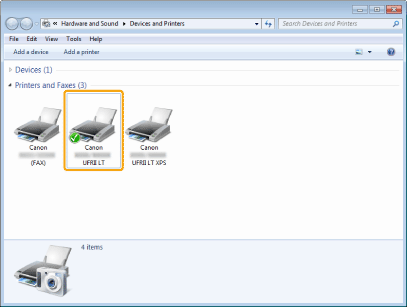
Checking the installation results
Check that the MF drivers and MF Toolbox are installed correctly.
Check that the icons for the installed software are added as follows.
| Software | Location | Icon |
| Printer driver | [Devices and Printers] folder |  |
| Fax driver | [Devices and Printers] folder |  |
| Scanner driver | [Scanners and Cameras] or [Scanners and Cameras Properties] folder | For network connection |
For USB connection |
||
| MF Toolbox | Desktop |  |
| Network Scan Utility | Taskbar |  |
